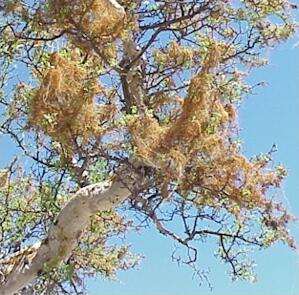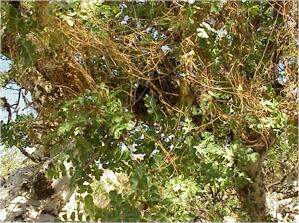|
Elephant trees are large shrubs or relatively small trees, characterised by their thick, swollen trunks which serve for water storage. They are very common in the drier desert regions of the Baja California peninsula (mexico) and also in the western parts of mainland Mexica (Sonora), but only one of the elephant trees (Bursera microphylla) extends into the most southerly part of the USA. These trees typically have pinnate leaves that are shed in drought conditions, but the plants can photosynthesise through the stems of the trunk and major branches, which have a white, papery bark overlying the green photosynthetic tissues.
One of the common elephant trees (Bursera microphylla) is characterised by its reddish-brown twigs, its pinnate leaves with minute, regularly arranged leaflets, and its small rounded berries. This plant belongs to the torchwood family (Burseraceae), which has many representatives around the world, including the trees used to produce frankincense and myrrh. In fact, the desert species, B. microphylla, also has strongly aromatic foliage.
The other common elephant tree of Baja California is Pachycormus discolor (the term "pachy-" meaning elephant-like, because elephants are pachyderms). This plant is in a totally different family (the cashew family, Anacardiaceae) and yet looks almost identical to B. microphylla. The main features that help to distinguish it are the greyish twigs and the pinnate leaves with larger, irregular leaflets. The two plants often grow together in the same habitat and look almost identical when not in leaf. For example, the image below shows three elephant trees on a dry, rocky slope. The tree on the right is Pachycormus, whereas the centre and left-hand trees are Bursera.
This is a classic example of convergent evolution - two organisms that have evolved the same adaptations to cope with particular environmental circumstances. However, there is an ecological difference between these two plants - only Pachycormus responds to winter rainfall by growing and producing leaves. Burseras are dormant in winter.
On some lava hillsides towards the eastern (drier) regions of Baja California, Pachycormus can form almost pure stands, shown in the image above. In other regions, with potentially more moisture, the elephant trees are found in mixed communities with many other plants. In the regions where winds carry moisture-laden air from the Pacific Ocean, both Bursera and Pachycormus can be heavily parasitised by dodder.
|
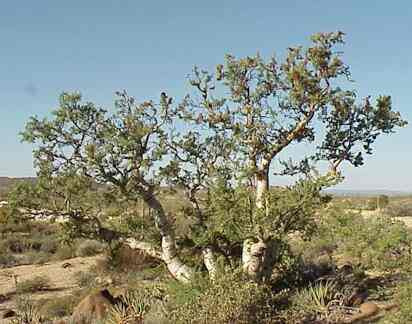

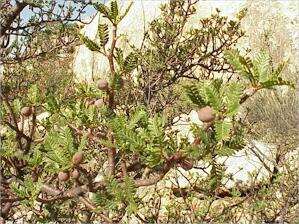
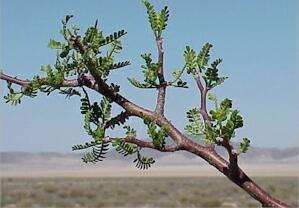 Characteristic reddish brown twigs of B.
microphylla
Characteristic reddish brown twigs of B.
microphylla


